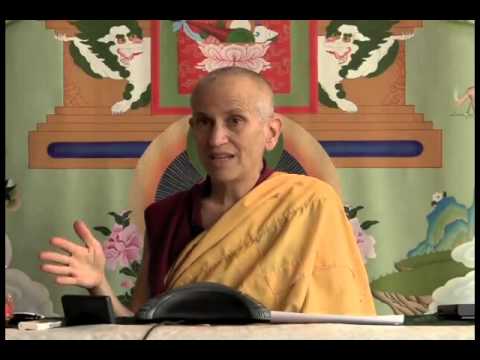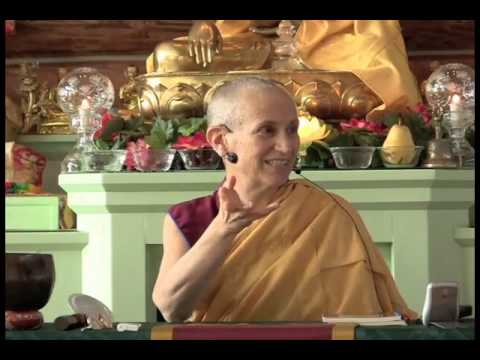Value of a supportive community for monastic training

I have been living at Sravasti Abbey as an anagarika (someone keeping eight precepts) since October 2011. After my attendance at Exploring Monastic Life in August 2010 I took the eight precepts as an anagarika but did not shave my hair or take on the blue anagarika clothes as I had to go back to Germany to finish my commitments at work and to pay off my university debt. The training began with an official request in November 2011. This ceremony was very helpful to me, as I officially committed myself to this training in front of the whole community. In the same ceremony, the monastics made a commitment to support me in the process. The purpose of taking the precepts and doing this training is to live a lifestyle that leads to becoming a good Buddhist practitioner, to serve the Buddha-Dharma and all sentient beings.
During the anagarika training I have experienced training my mind in the community by, for example, working on my attachments and personal preferences. When my self-centered attitude is active or when habits arise that are focused on serving myself as an individual instead of the community, I receive feedback from the community as well as from the abbess, to identify and understand these patterns and the antidotes to them. We have many opportunities to work with our minds within the supportive container of the monastic community.
I have now about nine months experience living in this community. I find it has been a good experience, to go slow, to learn about the community first before I commit myself for many years of living and practicing together. Every day we practice meditation in the morning together, eat together, work together, have teachings and discussions together, then eat again together, practice meditation in the evening together again and, last but not least, it could be possible that we even share a bedroom together.
So we are really very close. This often requires patience and you get a lot of support, as the community is eager to develop harmony. At Sravasti Abbey we have a number of ways to help achieve and keep a harmonious community. We practice and train in Non-violent Communication (NVC) and we have a skilled abbess and teacher, Venerable Thubten Chodron, who supports us with advice and direction. So if a conflict arises we work it out with NVC or we ask for Venerable Thubten Chodron’s support.
Also the shared goal of our daily spiritual practice is to grow in compassion and wisdom and to support a peaceful community. To live harmoniously together is a major part of our training here. This can take time but it’s worthwhile, as this life in a Buddhist monastic community is a rare opportunity to support ourselves and others in transforming our minds. For example, a person who has a habit of becoming angry quite easily can understand and change that habit through the help of his/her practice, through the support of the community and the teachers, into a very peaceful, loving, compassionate person.
All anagarikas here are assigned a monastic mentor or personal guide. I asked Venerable Tarpa, who is my personal guide and the longest ordained monastic here besides Venerable Thubten Chodron, the following question: “How do you value a supportive community for pre-trainees (anagarikas) and monastics in training? Can you please speak from your own experience as well as an observer?”
She responded: “In my life I had plenty of opportunities to learn many things. But there are many things I would have never learned without living in this way because of the intention and vision of the community and the common worldview that we share. In addition, we have a very wise and compassionate abbess. I have been able to learn things that I didn’t learn elsewhere in fifty years. The mirror gets turned here and you can see your faults and you see your strengths and you have the tools to deal with all of this.”
I am happy that I could find this excellently structured and positive community. Some of the issues I have worked with since joining the community include how to work with afflictions that arise throughout the day, how to communicate my needs and at the same time keep the needs of the community in mind.
For example I had to work with my anger when I did not get accomplished what I wished to do. Normally I have the tendency to blame others for my anger. They are the cause for my unhappiness. Here at the Abbey I have become cleared that the anger is in my mind. I am responsible for my own afflictions. I realized that my afflictions adversely influence some members of the community. My anger can make our lives disharmonious. That’s not what I was searching for. I was looking for a peaceful and harmonious environment. So I am more aware how my mind is running the show. I try to use antidotes such as loving-kindness for myself and others and to find the underlying causes for these afflictions.
I have the tendency to take people’s comments and feedback very personally, thinking that they are criticizing me when they aren’t. I don’t immediately consider what they are thinking and feeling that made them say this. I see often this as a complaint or think people don’t like me. Here at the Abbey I learned that I can first stop this confusion, listen to my mind and discover in what state of mind I am. I don’t have to react right away. Then I’ll gain some space in my mind, get rid of some tightness that could poison the following conversation and then I am more able to listen to others needs and feelings. If I am able to do this, it can lead to a more harmonious and kind communication in consideration of their needs.
So it needs some investigation to develop a mind that considers the needs of others and hears the needs of the community. If I myself am too tight in my mind, for example I’m angry, then I can’t meet the needs of others. Then it’s really hard and I don’t feel very happy in this environment. It’s not about the others. It’s the way that I deal with my afflictions, my reactions, my habitual behavior towards them. I can apply the antidotes like loving-kindness and compassion. We can’t have two mind states in the same moment. So anger will vanish when loving-kindness is taking over the place. This will open the mind for others and at the same time I will receive the beautiful fruits as well.
When I ordain and become a part of the sangha, then I will go deeper into training with the other monastics and with my teacher. Therefore I need to build trust in the community members, confidence in myself, a willingness to learn, and patience and humor will help, too. After about nine months here at Sravasti Abbey I can say that this time as an anagarika preparing to become a nun was worthwhile, even though I aspired to become a monastic much sooner.
It could be quite difficult if we enter a community, get ordained and after some time we find out that we can’t stand this life or the community anymore, that we are really not able to work and practice with our spiritual friends. What are we going to do then? It could be that we are in the middle of training (the traditional monastic training in the Tibetan tradition takes about ten years), and we are dissatisfied and want to leave and find another community. This will not only interrupt our training but also, do we know that we will get better along with the new community? Maybe similar issues will show up. We can prevent this by choosing our community well, taking time to get familiar with each other and to experience living together before taking any monastic precepts.
To come, live and train as an anagarika is really a good opportunity to check out if you want to practice in this Buddhist community. By exploring monastic life in this way, we develop some confidence in becoming a monastic. As monastics we will have precepts and after some years, more responsibilities. It is helpful to step into this gradual training slowly and build up your knowledge about monastic life, so that you become confident in the precepts and the new role. It’s like first pouring a foundation when building a house. If the foundation is well done, the house will be stable and last longer. In terms of becoming a monastic, if we have a good foundation, we will be able to be of benefit to sentient beings and the Buddha’s teachings.
Venerable Thubten Jampa
Ven. Thubten Jampa (Dani Mieritz) is from Hamburg, Germany. She took refuge in 2001. She has received teachings and training from e.g. His Holiness the Dalai Lama, Dagyab Rinpoche (Tibethouse Frankfurt) and Geshe Lobsang Palden. Also she received teachings from Western teachers from the Tibetan Center in Hamburg. Ven. Jampa studied politics and sociology for 5 years at the Humboldt-University in Berlin and received her diploma in Social Science in 2004. From 2004 to 2006 she worked as a Volunteer Coordinator and fundraiser for the International Campaign for Tibet (ICT) in Berlin. In 2006, she traveled to Japan and practiced Zazen in a Zen monastery. Ven. Jampa moved to Hamburg in 2007, to work and study at the Tibetan Center-Hamburg where she worked as an event manager and in administration. On August 16, 2010, she received the Anagarika vows from Ven. Thubten Chodron, which she kept while fullfilling her obligations at the Tibetan Center in Hamburg. In October 2011, she entered training as an Anagarika at Sravasti Abbey. On January 19, 2013, she received both the novice and training ordinations (sramanerika and siksamana). Ven. Jampa organizes retreats and supports events at the Abbey, helps with offering service coordination and supports the health of the forest. She is a facilitator for the Friends of Sravasti Abbey Friends online education program (SAFE).


